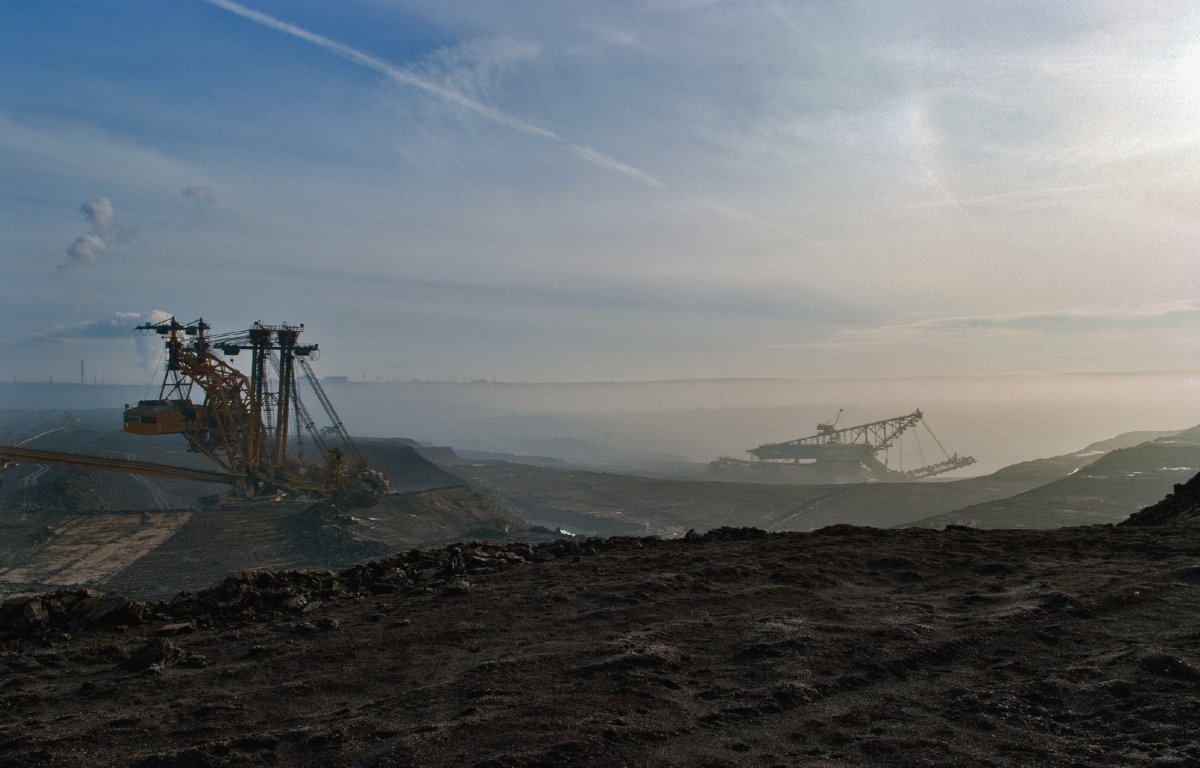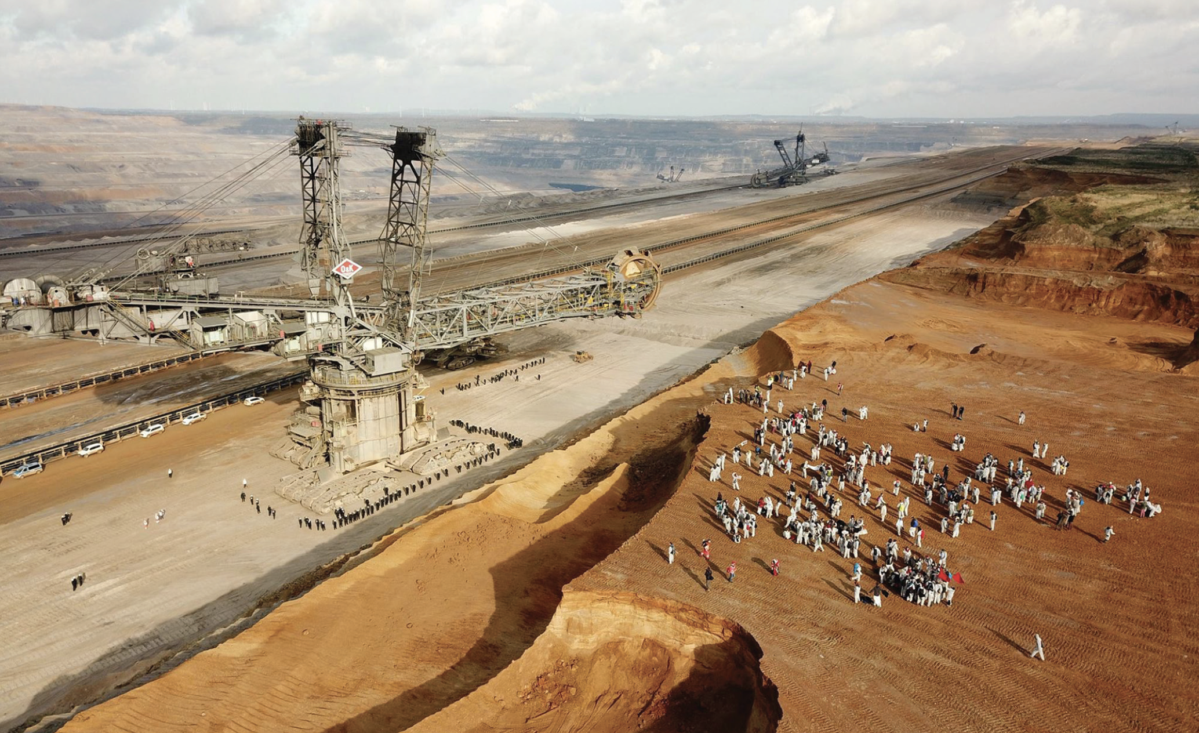
In the shallow waters of the Caspian Sea, about 60 miles to the east of Azerbaijan’s capital Baku, lies a massive construction known as Neft Daşları: the first oil platform in the world, rising above the surface on the wrecks of seven intentionally sunken ships serving as an artificial base for a tangle of steel bridges and concrete platforms whose total length exceeds 190 miles. The city on water has been inhabited by roughly two thousand workers since the late 1940s when the government of the then Soviet republic, after huge oil reserves were discovered in the Caspian Sea, decided to build the megalomaniac system of subsea wells, industrial buildings and precast concrete apartment blocks to assume a leading position in the global production of black gold which solicitously greased the gears of the socialist as well as capitalist version of modernist economy.
From above, the whole structure reminds of the complicated, seemingly chaotic rhizomes from the works by Deleuze and Guattari: @@1 miles and miles of bridges are interlaced by junctions in which several routes cross; as a whole, this architecture makes no sense; unless we realize that in fact, it copies the logic of distribution of natural reserves of oil under the sea bottom. The construction is both slender and vast, looking like a paratroop from another planet, ready to wring the subterranean wells of the concentrated energetic remains of the younger epochs of the geological history of our planet, collect samples and fly them to a parallel universe.
Infrastructures of Ephemeral Extractivism
The history of Azerbaijan’s oil industry dates back to 1846 when engineer G. V. Alexeyev established the first oil well in the world at the Bibiheybɘt oil field in the vicinity of Baku. The small Transcaucasian country thus became a vanguard of oil industry since its very dawn. Today, Azerbaijan’s largest oil field in the waters of the Caspian Sea – known as Azeri-Chirag-Gunashli – spews out 850 000 barrels of oil a day thanks to a system of seven oil platforms administered by the AIOC (Azerbaijan International Operating Company) consortium including corporations such as BP, Amoco and Lukoil. The oil field secures 65% of the entire production of oil in the Azerbaijani territory and in comparison with the outdated technologies of the Neft Daşları platform, it represents one of the most modern oil infrastructures in the world. @@2 The architecture of these demonic objects embodies the key principles of extractivism as an economic paradigm based on massive extraction and processing of rare, non-renewable resources; with an emphasis on robustness and solidity, mixed with the principles of modularity, flexibility, mobility and storability. These principles are articulated in the ephemeral urbanism @@3 of enclaves and exclaves when a state of exception, i.e. of occupation by an army of machines frenetically penetrating the surface of the planet, is declared over the extraction locality. @@4 Therefore Neft Daşları, for instance, cannot be found on freely available satellite images; similarly to other Azerbaijani oil platforms. @@5 As if the throbbing heart of fossil economy existed in a special regime in which it is taken out of the “natural“ course of things; as an invisible base pumping life-giving substances into the ephemeral world we are to inhabit. Another example can be seen in Czech Republic’s Most Coal District and primarily the iconic Czechoslovak Army Mine. Although the latter can be seen on maps with its gigantic excavators revealing the overburden and sinking its teeth into the tasty blocks of lignite, there is no doubt that an unusual regime prevails both inside and outside the individual quarries. The fact that it is a strange territory consecrated to a certain dark cult is obvious simply from the visual aesthetic of the locality which stretches almost to the limits of Litvínov and Most.
However, ephemeral urbanism is not a necessary part of extractivism, rather being tamed or usurped by it. Its principles are embodied in the form of various “temporary autonomous zones” which are not dissimilar from pirate enclaves or networks of medieval Assassins described by Hakim Bey. @@6 Sean Cubitt @@7 thinks along similar lines, comparing the architecture of contemporary capitalism to the decentralized infrastructure of al-Qaeda branches rather than to the totality of the Empire described by Negri and Hardt. @@8 Moreover, these zones are excluded from common symbolic circulation and therefore show signs of sacral places in many respects: their visual representation is strictly limited (for instance, taking pictures is forbidden at oil platforms) and their operation follows autonomous rules (the entire Azeri-Chirag-Gunashi oil field is exempted from Azerbaijani jurisdiction and administered by the above mentioned consortium of corporations). Furthermore, the vastness of the production and logistic networks connected to extractivism is an often displaced aspect of the political-economic analysis of capitalism. However, real social and economic power does not dwell in the buildings of national and international institutions, rather circulating like blood in the capillaries of material infrastructures. @@9 At first glance, capitalist modernism may seem like a perfectly clean, abstract space (and it even likes to shroud itself in this elegant disguise); however, in fact, the entire assemblage is dirty, flagrant and forever temporary: its viscera are turning black due to fossil fuels, its skin is splashed by the hot sweat of workers in the docks of Guangzhou, Shanghai, Hamburg and Rotterdam; its favorite geometric manifestations being the container cube or the cylindrical tank.

The Carbosilicon Machinery
When the individual types of these production and distribution apparatuses are superimposed upon each other, they create a dense network that can be seen as the material substance of capitalism. If we stick to Marx’s distinction between formal and real subsumption of labor under capital, then real subsumption is ultimately realized only at the moment when the labor of humans and non-humans becomes trapped in the production machinery not only within the symbolical and economic order but literally (bio) physically. As Swedish historian and political ecologist Andreas Malm points out, the mechanism of real subsumption is kept in operation by the gargantuan organization of fossil industry. @@10 Furthermore, if we follow the example of Benjamin H. Bratton or Matteo Pasquinelli and take into consideration the emergence of planetary-scale computation and the role of digital technologies in establishing the neoliberal order of the past three decades, we can start talking about the carbosilicon machine (Pasquinelli) @@11 whose theoretical representation is provided by Bratton’s multi-layered model of The Stack. The latter consists of six layers – Earth, Cloud, City, Address, Interface and User. In brief, the first layer constitutes the mineral-energetic and biochemical basis organically interwoven with the extractive apparatus above which grows the infrastructure of digital economy in the form of optic cables and remote data centers. Earth provides an underlying base to the network of interfaces (layer five) interconnected by an address system (layer four) in the natural habitat of their end users (layer six) which is the urban type of settlement (layer three) today. @@12
The fact that capitalism shows the signs of cybernetic architecture allows us to abandon the cartographic idea of this socio-economic system as a hermetically closed capsule continuously surrounding the entire planet; for any network can be laid out on a global scale without simultaneously occupying all territories; for instance, let me mention the fragmentary logic of the placement of data centers and optic cables of planetary-scale computation as well as oil pipelines, gas pipelines and other infrastructures from an “older” generation. Although the planet is thus really affected by capital as a whole, not everything found on its surface is identifiable with capitalism. This basic intuition was aptly put by Anna Tsing: capitalism relies on the rich networks of non-capitalist nature. @@13 The list of the non-capitalist material substrates of capitalism includes a whole range of ecosystem services from water, carbon and other chemical cycles through climatic regulation to the regeneration of farmland, as well as other types of non-paid labor: primarily the one related to care and reproduction, usually delegated onto the shoulders of women in our patriarchal society. The carbosilicon machinery thus does not exploit human labor (or life as such) but rather subjugates a whole series of human and non-human aspects of the planetary assemblage. @@14 However, in terms of the specific nature of these aspects, the whole machinery remains strictly agnostic. All the labor done in the services of capital is thus a labor of composite cyborgs. @@15 Human labor becomes a freely combinable component within a whole conglomerate of production forces which further include other machines, sources, raw materials and procedures of processing energy, matter and information. Within this assemblage, humans enjoy no privileged position. In this context, Italian philosopher Maurizio Lazzarato speaks of machinic enslavement which corresponds to Marx’s idea from Grundrisse concerning mechanization and automation as a final stage of the development of capitalist production forces. @@16 Its characteristic feature is the dividualization of individuals: human lives are turned into homogenous quantities of time and energy that can be freely mobilized for the purpose of extraction of surplus. @@17 However, since the perspective of carbosilicon machinery does not distinguish between humans and non-humans, what is ultimately dividualized are the production forces as a whole; the units that thus arise are subsequently newly composed into ahistorical, cybernetic wholes that are deprived of the thermodynamic dimension of mobility in the planetary terrain. Fossil fuels have become vital for this process of abstraction. Why?
Fossil Capital
In his work Fossil Capital (2016), Andreas Malm introduces the detailed process by which fossil fuels – after the initial stage of experimenting with various sources of energy – were tamed by the capitalist production mode. The use of coal in British cotton and textile industry in the first half of the 19th century started a technological revolution which caught the United Kingdom and gradually the whole world in the evolutionary trap of fossil fuels which became a general and indispensable energetic substrate of commodity production and thus also of surplus value exctraction. The spatiotemporal profile of fossil fuels such as coal, oil and natural gas enabled the capitalist production mode to easily abstract from the particular characteristics of individuals since these sources of energy are mobile, homogenous, easily storable and calculable. @@18 Of course, this characteristic of fossil fuels does not lay the foundations of capitalism and its mode of abstraction (after all, coal has been mined and used in the territory of the United Kingdom primarily for heating since the times of the Roman Empire); on the contrary, Malm himself has based his argument on the claim that the formation of this socio-economic system historically precedes the rise of fossil fuels and thus preconditions their boom. It was only the crystallization of a new class antagonism between the laborers and the owners of production means which led to the fact that the latter class started using technologies driven by coal energy in the first half of the 19th century for the purpose of an economic subjugation of the former.
Coal and other fossil sources of energy thus began to systematically contribute to the calculative mechanism described in the first chapter of the first volume of Capital. There, Marx explicates the exchange-value of commodities as congealed labor time, or a solidified form of abstract social labor. @@19 Commodities are of homogenous quality and as such, in their exchange-value, they represent human activity merely as quantities of abstract labor in whose register various individual givens of human lives and specific characteristics of activities leading to the production of the given commodity are completely ignored. @@20 Lazzarato’s description of dividuation updates this classic Marxist etude for the 21st century as he tries to include both cognitive labor and non-human actors in the description of the capitalist method of abstraction.
To understand the relation between fossil fuels and capitalist abstraction, it is necessary to state two central mechanisms: the production of abstract space and abstract time. These two abstractions are in fact abstractions of the constitutive elements of Earth as a coherent geophysical unit. Their description can start off with Bergson’s old distinction between quantitative and qualitative multiplicity. While quantitative multiplicity is homogenous and has a unified system of coordinates for its measurement and description, qualitative multiplicity is measurable only on the basis of variation of metric principles in each section; such multiplicity is thus strictly heterogeneous and its components differ both numerically and by their type. @@21 On the basis of this distinction, we can also understand the category of abstract space which Henri Lefebvre puts into contrast with absolute space (an example of which can be seen in the city or house you find yourself in now) @@22 and the category of abstract time which Moishe Postone distinguishes from concrete time (for instance the time of cooking rice or making tea). @@23
When the calculative regime of capitalism finally organically grew together with its energetic basis in the form of fossil fuels, their spatiotemporal profile enabled them to dissolve the regime of concrete time, as the production process finally broke out of the rhythms of individual biochemical and structural ecosystem processes. @@24 The walls of absolute space fell, too, as the production process freed itself from its bond to the places where the individual sources and components necessary for commodity production were “naturally” found; fossil fuels enabled to concentrate all elements of the production process in a single arbitrary place. @@25 Extractive infrastructures were reinvented as an organization of space leading to the annihilation of space (and to the denial of planetary thermodynamics). @@26 The cosmopolitan nature of oil barrels therefore still enables capitalism to break the world into pieces in a barbarian way and reconstruct these pieces into strange monsters. The world has become similar to an archive or a database whose components are separated from each other and carefully stored, waiting to be called to action. @@27

Regimes of Abstraction
Quantitative multiplicity, abstract space and abstract time thus constitute a terminological triad; which, together with abstract social labor and the term of dividuation, falls within the register of exchange-value as an essence of commodity in capitalism. These are opposed by qualitative multiplicity, absolute space and concrete time, which belong to the world of use-values, which have the form of particular human and non-human activities as well as processes emerging out of their rich networks. Capitalism is thus a system of translation of non-capitalist heterogeneities (which do not necessarily fall within the register of use-values only) into a primitive, homogenizing vocabulary of exchange-value.@@28 However, I do not mean to depreciate the significance of abstraction; on the contrary, I want to emphasize that we need more rather than less of it. I believe that it is the task of both philosophers and a wide variety of art and intellectual disciplines (which – let us admit it – have always significantly overlapped) to codify a new order of abstraction; since the question of what we consider an adequate form of abstraction can be ultimately resolved only by aesthetic choice. Such an effort must start by a kind of a phenomenological analysis: we must turn our attention to things, observe them and be instructed by them in our construction of the ethereal world of proto-theoretical intuitions. We can proceed like Aristotle when he defined time as the measured movement of bodies.@@29 These bodies, however, are endowed with various kinds of movement; some of them come and go in cycles, others only appear in exceptional situations, while others still pass by us and never come back. That is why there are multiple registers of temporality. Similarly, human activities fall within many registers; the spatiotemporal logic of play is different from the logic of care, entertainment, sexuality, education or idleness. In other words: the wit of decent abstraction consists in its being an often unacknowledged continuation of anthropology by other means. What remains an open question is thus the following: how to construct technologies for a systematic operation of these new regimes of abstraction? And what to do with the monuments of the past regimes; for instance the water city Neft Daşları on whose platforms extractive activities will stop for good one day and the whole behemoth will continue rusting in the shallow waters of the Caspian Sea?
INFO
essay in Artalk Revue 1
2017